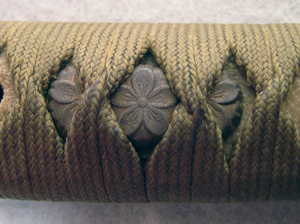Oil Quenched Showa Katana in Good Polish with Odd Mounts
Signature: Mei is not really readable, a possible guess is Fukushima Masahiro.
Year Made: WW II era
Forging Pattern: Muji hada
Tempering Pattern: Midare in nioi
Dimensions: Blade Length: 24.75 inchesNakago: 7.75 inches 8 mm thick and 32 mm wide at Hamachi
Mountings: 1934 pattern shin-gunto mounts. The mounts are odd in that they appear to be set up to be worn as a traditional katana (through the sash, cutting edge up) there is no suspension ashi on the saya and no sign of there ever having been one, no holes of any kind in the tsuba, a plain copper fuchi and a brass habaki. The koi guchi on the saya was set up for a latch. I have never seen this set up before. The mounts are of middle quality and in good condition. Some paint loss to the saya and corrosion to the menuki. The kabutogane is of odd design without the usual cherry blossoms and leaves but has a nice sarute. A cast brass habaki is also unusual. There is only one seppa. The mounts do not appear to be reproductions.
Overall Condition: Good. The sword is in good polish and appears to be well made with a nice suguta and extended chu-kissaki. The bright nioi hamon stands out well and there are only a few scratches, shallow pits and tiny nicks to mar the surface. There are no arsenal stamps but the sword has every sign of being yakiabura (quenched in oil, not water). This is our opinion and it is always possible that it is a traditionally (or partially traditionally) made sword done in a plain nioi hamon, There were many tricks and secrets used by smiths back then, so we leave the final determination to the buyer. In any case, it is a graceful looking sword in good polish and even the yasurimei (file marks on the nakago) were carefully done. It would make a fine collectible for the unusual mounts or an excellent martial arts sword for someone small in stature. As far as the translation of the mei, we are fairly certain of the first and last ji, the middle two match nothing in any of our books of kanji but with a large leap of imagination one could possibly get the translation given. If someone has an alternative we would love to hear it.








































































